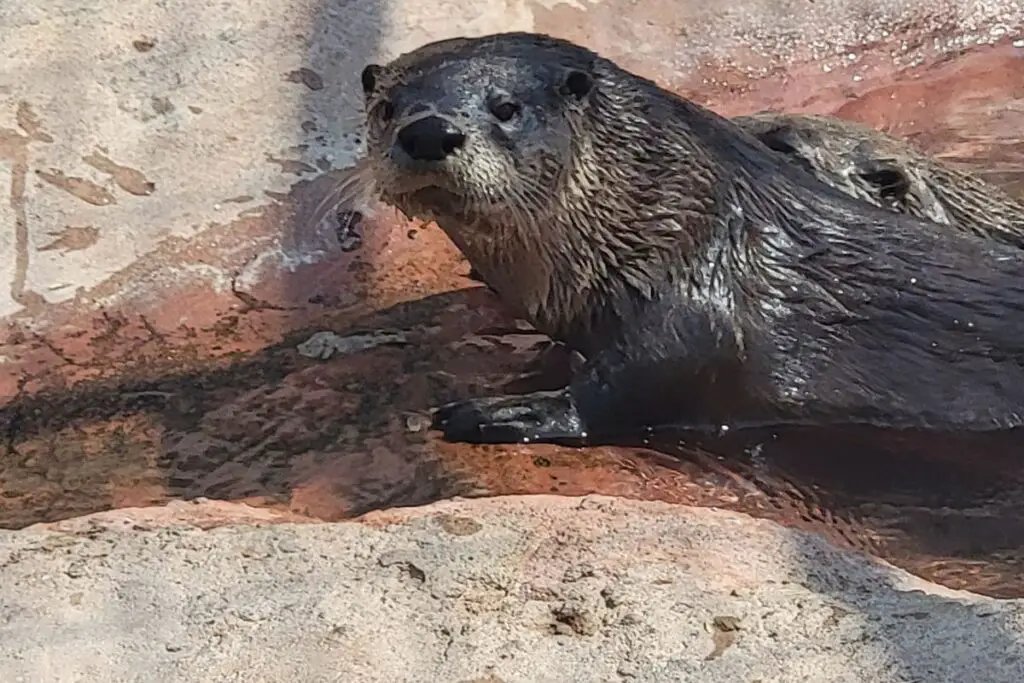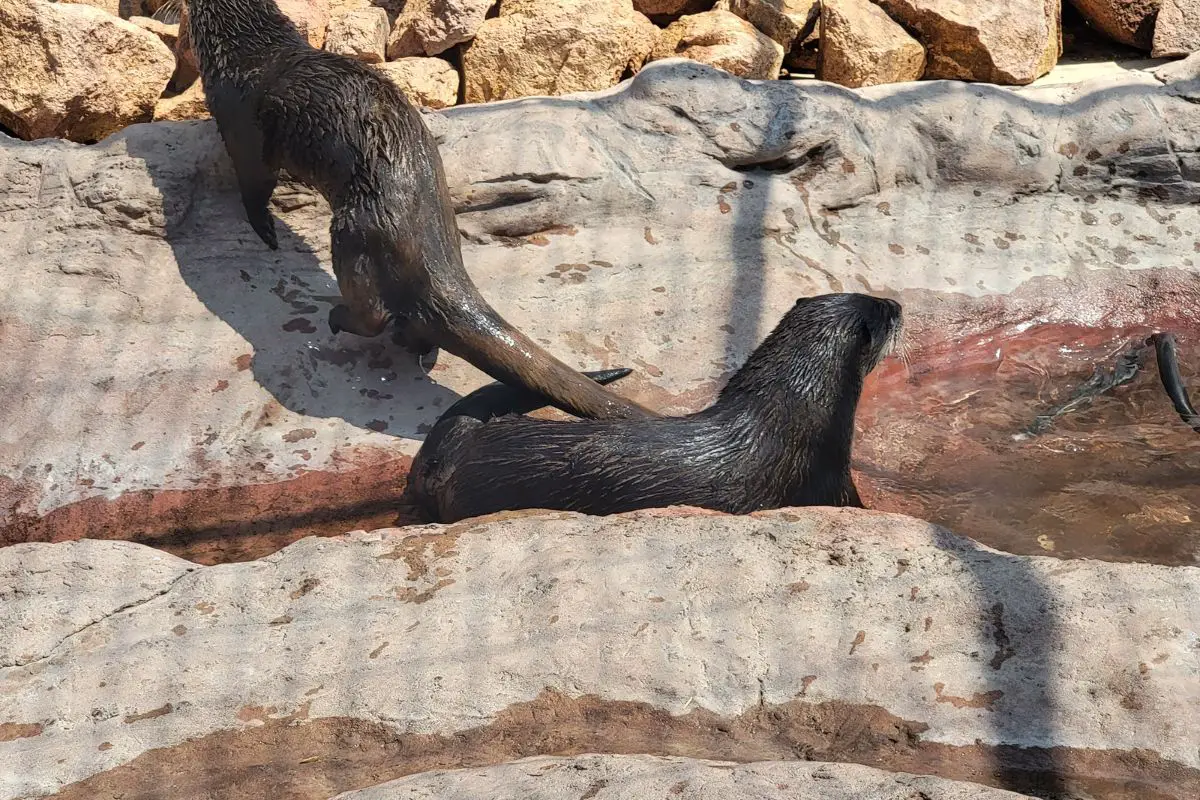When it comes to otters, you can be certain of two things.
One, they eat a lot! As much as 25% of their body weight each day! That’s a lot of anchovies.
Two, they move around. Otters can have multiple den sites that they visit throughout the year.
What is an Otter Den?
Otter dens are home to families of otters during the breeding season, which is typically from January through March. Otters like to move around their territory, so they may not occupy the same den every night. In fact, many river otters only stay in the den for a few months until the baby otters are capable of swimming and navigating river currents.
And some otters prefer to sleep under the open sky. How adventurous is that?
How Many Kinds of Otters Are There?
First, it’s essential to learn about the different types of otters because there are a lot of them! Otters are 13 members of the Lutrinae subfamily and are native to many different areas of the world, including Britain, North America, Europe, and Japan.
Some otters live in the ocean while others prefer coastlines, riverbanks, and even lakes.
Otters possess a thick coat of fur to keep them warm while swimming in cold water. In fact, their coat is the most dense coat of any mammal. It enables them to trap air in their fur to insulate their body since they lack the significant blubber reserves of seals.
They use their powerful webbed feet to glide through the water while they hunt small prey like crabs, sea urchins, and fish. As we mentioned before, otters will consume up to one-third of their body weight per day in food.
What Are Otter Dens Called?
Not every otter lives in a den. River otters are opportunistic and don’t build their own dens. Instead, they prefer to use naturally occurring coverings like tree roots near a riverbed or an old beaver dam.
When river otters use a den, it means they’re ready to give birth. The female river otter will seek out a shelter that has an underwater entrance to protect her babies from land-borne predators. Otters are capable of delaying conception until an ideal den is found or food sources improve. A female otter gestates for about two-and-a-half months, but they rarely are visibly pregnant.
Otter dens, even though they are often secondhand beaver dens, are called a holt or a couch. Otters really are the original advocates for “reuse and recycle.” River otters will then line their dens with a mixture of materials such as kelp and grasses to make a cozy nest for their babies.
Some otters don’t live in dens and prefer to camp out on a warm rock or shoreline during the day. Otters are most active during dawn and dusk and sometimes overnight, so any otter not in a den can often be spotted floating or basking in the sun. Males and young adults often strike out on their own and live alone.
How Many Otters Live in a Den?
Otters are highly sociable creatures and often live in groups. In some cases, a family group of otters comprises a monogamous mated pair, older offspring, and newly born babies, which are typically born from January to March. In other cases, males stay separate from females except during breeding season.
This otter family hunts together and protects the den, allowing for more successful otter rearing. An otter family may have multiple dens in its territory and will move between them depending on the weather and the food available.
River otter pups are born blind and helpless and stay exclusively in the den for the first few weeks of life. At a few months old, they venture out of the den to learn to swim and hunt independently, but they will stay with their family group for up to several years as they learn their territory.
Sea otters have a different method of raising their pups. Newly born pups float due to their dense coats, and while the mothers are hunting, they will be tangled up in seaweed to keep them from drifting off.
Sea otter pups stay on their mother’s stomachs until they can swim on their own. After they lose their baby fur, they are capable of submerging and hunting underwater.

How Far Will an Otter Travel From its Den?
Otters that use dens have large territories of over 15 square miles they protect and utilize, this is known as their home range. River otters will travel up to 18 miles in a day exploring, hunting, and defending their turf. Otters prefer to stay in or near the water since they have fewer natural predators in the water.
Otters on land can be subject to attacks from coyotes, dogs, bobcats, and even owls. They will use their strong legs to propel themselves over shallow areas and snowbanks to get to the next area of water.
Sea otters don’t have as large of a territory as these social creatures make their own homes with other otters in interlocking groups called rafts. This occurs when otters group together and hold hands or tie themselves to the same patch of seaweed so they don’t drift apart.
Not only does this make for devastatingly cute photos, but it also gives otters a chance to socialize and play. Otters have been observed to play many different games. One example of a favorite otter pastime is dropping a rock in the water and catching it on their forehead.
Do Otters Reuse a Den?
A female otter may seek out the same den if she enjoyed it the previous breeding season. However, since their dens are located on rivers, they are subject to seasonal stresses such as freezing, flooding, and other animal usage.
As a result, otters will often look for new dens or relocate between dens to stay in the best accommodations the river has to offer.
In rare cases, an industrious otter will dig its own den into the side of a riverbank or it will expand on an existing den, such as a rabbit warren or beaver dam.
How Can I Find an Otter Den?
Otter dens can be challenging to spot because the entrance of an ideal den is underwater. This prevents predators from seeing the otters coming and going from the nest.
A few signs to look for include identifying existing beaver dams, looking for otter scat, which is distinctively smelly, and missing river foliage. Otters like to trim back foliage so they can roll around in the dirt. Some of this winds up as nesting material inside the den.
Otters can be territorial, so don’t approach them if you see them in the wild. It’s important to allow their population to recover from extensive hunting, and all wild animals should be treated with caution.
When breeding season is over, otters may no longer occupy their otter dens, preferring to sleep on the riverbanks or on a rock.
What Do Otters Do All Day?
Otters are highly intelligent creatures, and as such, they spend a good amount of their time sleeping and eating. Otters will often find rocks they favor for use as bludgeons to open clamshells. They store these treasures in a pocket of skin under their arm known as an otter pocket.
These favorite tools are selectively and expertly employed to crack open snail shells, clamshells, bones, and more. The otter then makes good use of its 36 sharp and strong teeth to crunch through fishbones and other impediments.
Otters are active hunters and will even drag large kills such as oversized fish to the shore for more efficient consumption.
In their free time, they spend a lot of effort on their appearance. Otters were hunted for their luxurious pelts for a reason – the fur is so dense because its buoyancy results from trapped air. Careful grooming and removal of pests, oil, and other mess ensure the otter is able to swiftly glide through the water without being bogged down.
In fact, otters are often endangered by oil spills because the oil interferes with their ability to float by slicking down their fur and removing the air pockets.
What Makes Otters so Unique?
Their playful antics have made otters much beloved on the internet, but otters actually serve an important ecological function as an indicator species. This means since they have a low tolerance for difficult living conditions, polluted water, and substandard food, the presence of otters indicates a balanced and healthy ecosystem.
Healthy otter populations still exist around the world despite extensive hunting. However, several members of the otter subfamily are more threatened because they are less adaptable to change in rapidly changing environments.
Conclusion
Otters are a resourceful and entertaining species to watch whether they live in the ocean or frolic in the river. If you are lucky enough to have otters near you, you can enjoy hours of entertainment watching them play, chase each other and eat. Otters truly have the right outlook on life. There are many places like aquariums where you can see Otters, in person!
Sources
https://portal.ct.gov/DEEP/Wildlife/Fact-Sheets/River-Otter
- Hero Farm Dog Survives Epic Battle with Coyote Pack - December 9, 2024
- The 10-Minute Bedtime Routine That Changed My Dog’s Sleep Forever - November 29, 2024
- Creating a Safe Space for Nervous Pets: Your Guide to Pet-Friendly Havens - November 25, 2024

